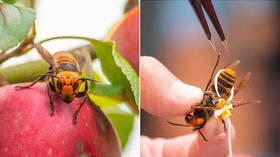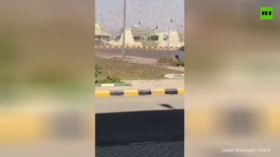‘Murder hornet’ tagged with tracking device escapes as Washington state struggles to find & destroy nests before ‘slaughter phase’

Researchers in Washington State have again failed to live-track a massive “murder hornet,” with the fearsome bug going fugitive as local officials attempt to locate and destroy nests before the insect’s bee-killing season begins.
The latest tracking attempt saw a public entomologist with the Washington State Department of Agriculture fix a tracking device to a female Asian giant hornet – better known by its more intimidating moniker, ‘murder hornet’ – but the bug made a break into a forest and the device went dark.
“The team and neighbors tracked the hornet from tree to tree for about an hour before losing her signal in the forest,” the department said in an update on Monday. “Both staff and several neighbors spent the remainder of the afternoon searching the area for the tracking signal (which would transmit for approximately 12 hours) but, unfortunately, it could not be located.”
Also on rt.com That’s one way to encourage social distancing! MURDER HORNETS arrive in US in the middle of Covid-19 pandemicInitially captured on October 5, the insect was stored in a cooler to “keep it calm” and fed strawberry jam, which “it seemed to like,” according to department entomologist Sven Spichiger, who observed that the bug “was a lot feistier” than previous specimens.
A previous attempt to track one of the aggressive arthropods – the largest wasp on Earth, measuring up to 2 inches in length – failed after a tracking device detached from the creature before it returned to its nest. The more recent effort used dental floss to attach the device instead of glue, but still to no avail.
While the insect’s sting has been known to be fatal to human beings, deadly encounters with people are somewhat rare. The bug’s nickname instead comes from its tendency to wipe out honeybee nests on a seasonal basis – what Spichiger termed its “slaughter phase,” which he noted is drawing near.
Native to Asia, only around 18 of the hornets have been spotted in Washington since they were first detected last year near the US border with Canada, however their devastating attacks on bee hives makes them a potentially serious pest, prompting the search-and-destroy efforts by local officials.
Also on rt.com Suspected sightings of ‘murder hornets’ in English city fuel fears of species’ spreadLike this story? Share it with a friend!














